Shape and Size Optimization of Truss Structures under Frequency Constraints Based on Hybrid Sine Cosine Firefly Algorithm
Ran Tao,Xiaomeng Yang,Huanlin Zhouand Zeng Meng
School of Civil Engineering,Hefei University of Technology,Hefei,230009,China
ABSTRACT Shape and size optimization with frequency constraints is a highly nonlinear problem with mixed design variables,non-convex search space,and multiple local optima.Therefore,a hybrid sine cosine firefly algorithm(HSCFA)is proposed to acquire more accurate solutions with less finite element analysis.The full attraction model of firefly algorithm (FA) is analyzed, and the factors that affect its computational efficiency and accuracy are revealed.A modified FA with simplified attraction model and adaptive parameter of sine cosine algorithm(SCA)is proposed to reduce the computational complexity and enhance the convergence rate.Then,the population is classified,and different populations are updated by modified FA and SCA respectively.Besides,the random search strategy based on Lévy flight is adopted to update the stagnant or infeasible solutions to enhance the population diversity.Elitist selection technique is applied to save the promising solutions and further improve the convergence rate.Moreover,the adaptive penalty function is employed to deal with the constraints.Finally, the performance of HSCFA is demonstrated through the numerical examples with nonstructural masses and frequency constraints.The results show that HSCFA is an efficient and competitive tool for shape and size optimization problems with frequency constraints.
KEYWORDS Firefly algorithm;sine cosine algorithm;frequency constraints;structural optimization
1 Introduction
Since the natural frequency has an important influence on the vibration of the structural system,it is necessary to constrain the natural frequency in the structural design to avoid resonance and damage.Bellagamba et al.[1]presented the seminal work on frequency constrained truss shape and size optimization,and since then researches in this area have developed rapidly over the past 30 years.
The structural optimization with frequency constraints aims to minimize the weight of the structure while ensuring the satisfaction of frequency constraints.Nevertheless,frequency constraints are highly nonlinear, nonconvex and implicit with respect to the design variables [2].Moreover,the mixture of shape and size variables can cause severe mathematical difficulties and divergence because of the different magnitude orders.The characteristics of the optimization problem limit the application of gradient-based algorithms in this field [3,4].Consequently, non-gradient-based algorithms, especially metaheuristic algorithms were developed to deal with this problem.These algorithms use stochastic searching techniques to select potential solutions,which have better global search ability with fewer limitations in application[5–7].However,metaheuristic algorithms still have some drawbacks such as time-consuming search and expensive computational cost.
Firefly algorithm(FA)is one of the nature-inspired metaheuristic algorithms based on the flashing patterns and social behavior of fireflies,and it can be considered as a generalization to particle swarm optimization (PSO), differential evolution, and simulated annealing algorithms through parameter adjustment[8,9].Therefore,FA inherits the advantages of the three algorithms and shows an impressive performance.Benefiting from the excellent global search ability, FA was successfully applied to various fields[10–12].However,the computational cost of FA is still expensive,and the exploitation ability has the potential for progress.Accordingly,different algorithms and techniques were combined with FA for improvements[13–16].These results confirmed that such hybrid algorithms outperformed the standard algorithms in terms of solution accuracy and convergence rate.Nevertheless, how to simplify the computational complexity of FA is still an unsolved problem.
Sine cosine algorithm (SCA) [17] is a recently developed metaheuristic algorithm, which uses the characteristics of sine and cosine trigonometric functions in the search process to solve global optimization problems.SCA has competitive performance compared with other algorithms[18–21].As SCA updates each candidate solution using the information of the global optimal solution, the exploitation ability and convergence rate are impressive.However, SCA faces some difficulties like falling into local optima and skipping of true solutions.Furthermore, SCA has not been applied to shape and size optimization problems of truss structures.
In this paper,the computational complexity of FA is reduced and a hybrid sine cosine firefly algorithm(HSCFA)with adaptive penalty function is proposed to deal with shape and size optimization of truss structures with frequency constraints.HSCFA takes advantage of SCA,FA,and Lévy flight to achieve a better balance between exploration and exploitation.
The remainder of this article is organized as follows.The mathematical model of the discrete structural optimization problem is presented in Section 2.The introductions of SCA,FA,Lévy flightbased local search technique, elitist selection technique and self-adaptive penalty function are given in Section 3.HSCFA is proposed in Section 4.The efficiency of HSCFA is evaluated in Section 5.Finally,the main conclusions are summarized in Section 6.
2 Mathematical Model of Optimization Problems
Generally, shape and size optimization for truss structures aims to minimize the weight while satisfying functional constraints.The design variables include the cross-sectional area of the members and the nodal positions of the critical members.Thus,the mathematical model can be expressed as the following Eq.(1).

whereWis the weight of the structure.For each memberi,ρimeans the material density,Aiindicates the cross-sectional area,Liis the length,xqis the nodal positions.nandmare the number of members and nodes,respectively.ωjandωj,maxare thej-th natural frequency and its corresponding upper bound.ωlandωl,minare thel-th natural frequency and its corresponding lower bound.Ai,minandAi,maxare the lower and upper bounds ofAi.xq,minand xq,maxare the lower and upper bounds of xq.
3 Preliminaries
3.1 Firefly Algorithm
FA was developed by Yang in 2008 [22], and it was inspired by the social behavior of firefly.In FA,three idealized rules are made including all fireflies are unisex,attractiveness is proportional to the brightness, and brightness is proportional to the value of the objective function.Then, the mathematical imitation of light intensity is settled.Obviously,the distance and air absorption affect the variation of light intensity,and the firefly’s attractiveness is proportional to the light intensity seen by adjacent fireflies.Therefore,the attractivenessβis formulated as the following Eq.(2).

whereβ0is the attractiveness ofr=0.The light absorption coefficientγindicates the strength of the attraction.In general,γdistributes in[0.01,100].The distancerijbetween firefliesiandjis defined as the following Eq.(3).

The movement of fireflyiis calculated by the following Eq.(4).

where Xtiis the position of thei-th firefly att-th iteration.αand‘rand’are the randomization parameter that take from[0,1].αis a constant that adjusts the random step of FA,and‘rand’is a random vector usually generated by Gaussian distribution,uniform distribution,and so on.
3.2 Sine Cosine Algorithm
SCA is a novel population-based optimization algorithm proposed by Mirjalili[17].SCA updates the movement of the search agents toward the best solution using a mathematical model based on sine and cosine functions.In SCA,the following Eq.(5)is used for both exploration and exploitation.

where Xtiis the position of thei-th solution att-th iteration.Ptmeans the best solution att-th iteration.r1is distributes in[0,2].r2can be taken from[0,2π].r3is a random number in[0,2].It can determine the effect of destination Pton the current movement.The parameterr3brings a random weight for the destination to stochastically emphasize(r3>1)or deemphasize(r3<1)the effect of destination in defining the distance.r4is a random number in[0,1]that decides the switch between sine and cosine components.The range of sine and cosine changes adaptively as the following Eq.(6).

wheretandTare the current and maximum iteration.ais a positive constant.The search range of SCA is illustrated in Fig.1 witha=2[17].
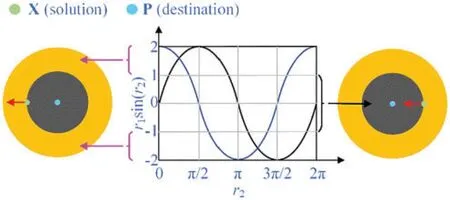
Figure 1:Search range of SCA
From Eq.(5)and Fig.1,the next position is inside the space between X and P when the values ofr1sin(r2)are in[–1,1].And it will be outside the space between X and P when the values ofr1sin(r2)are in(1,2]and[–2,–1).Thus,bothr1andr2determine the movement distance and search space.
3.3 Lévy Flight-Based Search Technique
Lévy flight was a non-Gaussian random process proposed by Chechkin et al.[23] in 2008, and its random walk is obtained by Lévy distribution.The direction of the flight is random,but the steps are distributed as a power function.Lévy flight has been successfully used to improve the heuristic algorithms due to its strong random search capability [24,25].The Lévy distribution is generally expressed asL(s)~|s|-1-β,wheresis distributed within the interval(0,2).Its mathematical expression is defined as the following Eq.(7)[26].

wheres,γandμare step size, control parameter of distribution scale and transmission parameter respectively.The Fourier transform of Lévy flight can be expressed as the following Eq.(8).

whereα∈[–1,1].The stability factorβis also known as the Lévy index and distributes in(0,2).The step sizescan be determined by the Mantegna algorithm as the following Eq.(9).

whereuandvhave Gaussian distribution as the following Eqs.(10)and(11).

whereΓ(z)is a gamma function that can be defined as the following Eq.(12).


Then,the Lévy flight-based local search technique can be defined as the following Eq.(13).where ⊕denotes Hadamard product.The values of the stagnation times of the particleNsand the number of constraint violationQare evaluated before updating the solution.The number of constraint functionsNgand the allowable stagnation timesNaare constants.The solutions will be updated by Eq.(13),whenQ=NgorNs=Na.
3.4 Elitist Selection Technique
The elitist selection technique was proposed for the selection progress [27].This mechanism is performed as follows:firstly, the last generation of population is combined with this generation of population to create a new group of population.Then,reorder the new population according to the fitness value.Choose the best half individuals of the new population to construct the population for the next generation.In this way,the better population of the two generations is always stored for the next generation.This technique helps the algorithm eliminate the poor individuals and obtain a better convergence rate.
3.5 Self-Adaptive Penalty Function
The penalty function method is one of the most popular constraint handling techniques[28,29].Based on this method, Tao et al.[12] proposed a self-adaptive penalty function strategy to solve constrained optimization problems.The fitness function is written as the following Eqs.(14)–(16).

wheregi(X)is theith normalized constraint function.σiandσiallare the actual value and allowable value ofith constraint,h(t)is the penalty parameter.The value of penalty function will increase with the increase of iterations, violation number and violation degree.It also makes sure that the second item of Eq.(14)has the same dimension and order of magnitude as the objective function.
4 Proposed New Developments
Generally,the accuracy of the optimal solution and the computational cost are two core indices to evaluate the performance of metaheuristic algorithms.In this section,HSCFA is proposed to enhance the solution accuracy and computational cost of FA.
4.1 Modified Firefly Algorithm
4.1.1 Motivation
The full attraction model defines the movement of fireflies in FA during the search process[30].In this model, one firefly is attracted by all other brighter fireflies.Moreover, the brightest one is not attracted by any firefly, and the darkest firefly is attracted by all other fireflies.The full attraction model is represented in Fig.2,in which both the volume and the luminous organ relate to the brightness of the firefly.The larger the volume is,the brighter the firefly is.

Figure 2:Attraction model among fireflies
As shown in Fig.2,firefly 8 is the darkest one,and firefly 1 is the brightest one.The seven brighter fireflies are attractive to the firefly 8,and no firefly is attractive to firefly 1.Thus,firefly 8 is hard to approach to the brightest firefly 1 with such an attraction model.To further investigate the attraction model,the real update formula for firefly 8 is given as shown in Eq.(17).

If the value of Xtjis larger than Xt8,the value ofis far larger than Xt8.Thus,the value ofis easily beyond the upper bound of the design variable.Then,the value ofwill be automatically adjusted to the upper bound based on the boundary control method of FA.This makes it difficult for the algorithm to obtain a variety of solutions.
The distancerijbetween firefliesiandjis affected by the different magnitude orders of the variables, especially for the shape and size optimization problems.If the value ofris always large,it will affect the convergence of the algorithm.In order to further investigate the change ofrthrough the iteration,benchmark functions with different design variable spaces are tested.The mathematical definition,search range and global minimum are listed in Table 1.The changes of the distancerduring the search process are illustrated in Fig.3.In the test,n=5 andd=5.

Table 1:Benchmark functions
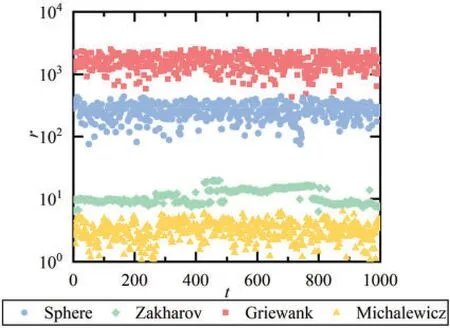
Figure 3:The changes of distance r
From Fig.3, the values ofrare different with varying search ranges.According to Eq.(2), the influence of different magnitude orders should be eliminated in the calculation ofrto ensure the effectiveness of the algorithm for different structural optimization problems.
Moreover, it also can be concluded from the full attraction model that the total number of attractions at each generation for populationnisn(n–1)/2.Let O(f) be the computational time complexity of the fitness evaluation functionf(·)[31].The Firefly algorithm contains an external loop based on the number of algorithm iterationsTand two internal cycles based on the population number n,so the computational time complexity of the standard FA is O(T·n2·f).
4.1.2 Modification
Although the attraction can enhance the exploitation ability, too many attractions on a firefly lead to uncertain search direction and weaken the exploitation ability.Therefore,the attraction model is modified and only one solution in the top three is selected to update the worse solutions to reduce the time complexity.Furthermore,the search range is introduced into the calculation ofrto address the different magnitude orders of the mixed variables.In addition,the fixed randomization parameterαslows down the convergence,and the redundant parameters of a hybrid algorithm will increase the difficulty of the algorithm’s operation.Thus,r1of SCA is utilized to replaceαof FA to accelerate the convergence.Eqs.(3)and(4)can be modified as the following Eqs.(18)and(19).

whereUbkandLbkare the upper and lower bound ofkth variable.Xtris randomly selected one of the top three fireflies.In the modified FA(MFA),the total number of attractions at each generation isn.Consequently,the time complexity is reduced to O(T·n·f).The changes of the distancerof MFA are illustrated in Fig.4.In the test,n=5 andd=5.
From Fig.4,the values ofrare distributed in[0,0.5].Therefore,the different magnitude orders of variables are conquered by the modification to fit different structural optimization problems.

Figure 4:The changes of distance r
4.2 Hybrid Sine Cosine Firefly Algorithm(HSCFA)
A hybrid sine cosine firefly algorithm(HSCFA)integrating modified FA,SCA,Lévy flight and adaptive penalty function is proposed in this section.HSCFA takes advantage of modified FA’s exploration ability, SCA’s exploitation ability, and Lévy flight’s strong random search ability.In order to ensure varied population diversity, the population is divided into two equivalent parts that used modified FA and SCA for solution update respectively.The random search strategy based on Lévy flight is employed to update the solutions that stagnate for several iterations or severely violate constraints to improve the population diversity.Thus,the stagnation times of each solutionNsis stored during the iteration, and the allowable stagnation timesNais set.The constraints number of each optimization problem is set asNg.In HSCFA,the elitist selection technique is adopted to replace the original selection way of FA and SCA to improve the convergence speed.
4.3 Framework of HSCFA
The detailed operation steps of HSCFA are presented in this section.The flowchart of HSCFA is shown in Fig.5.
As shown in Fig.5,the steps of the proposed algorithm are given in details as follows:
Step 1.Initialize the parametersγ,β0,a,Na.
Step 2.Initial solutions and the fitness values.
Step 3.IfQ=NgorNs=Na, the solutions update by Eq(13).Otherwise, the population is divided into two equivalent parts that used modified FA and SCA for solution update.Fori∈(1,n/2),every solution is updated by Eq.(5).Fori∈(n/2+1,n),every solution is updated by Eq.(18).
Step 4.The finite element analysis is applied.
Step 5.The results obtained by finite element analysis are treated by the adaptive penalty function method.Count the number of stagnationsNsper solution.
Step 6.Use the elitist selection technique to select the solution.
Step 7.If the terminal condition is satisfied,end the iteration.Otherwise,it goes to Step 3.

Figure 5:The flowchart of HSCFA
5 Experiments and Results
In this section,the initial parameters of HSCFA are investigated and four well-known structural design problems including two size optimization and two shape and size optimization examples are tested.These structural design examples are all minimization problems with frequency constraints[32–34].The optimization results of HSCFA are compared with SCA,FA and results of other methods in the existing researches.Different population sizes and iteration times are assigned to different experiments.Every experiment runs 20 times for SCA, FA, modified FA (MFA), HSCFA without Levy-flight and self-adaptivity of penalty function (HSCFA-1), HSCFA without self-adaptivity of penalty function(HSCFA-2)and HSCFA.
5.1 Investigation of Initial Parameters
Since the performance of HSCFA is influenced byβ0,aandNa, different initial parameters are tested by the benchmark functions in Table 1.The dimension of the problems is set to 10.The population size and the iteration time are 20 and 100,and HSCFA runs 20 times for all the cases.For convenience,some of the results are illustrated in Figs.6 and 7.
From Fig.6, the values ofFmeandecrease with the increase ofβ0for all the functions except for Michalewicz function.It is difficult to determine which value ofβ0is the most reasonable one for Michalewicz function.From Fig.7,the values ofFmeanchange irregularly with the increase ofa.The relationship between the values ofFmeanandNsare also hard to be summarized from Figs.6 and 7.Therefore,the Friedman and Wilcoxon tests are implemented to provide a more accurate evaluation of the initial parameters.The results are listed in Tables 2–9.The results of Wilcoxon tests below 0.05 denote the performance is much better than others.
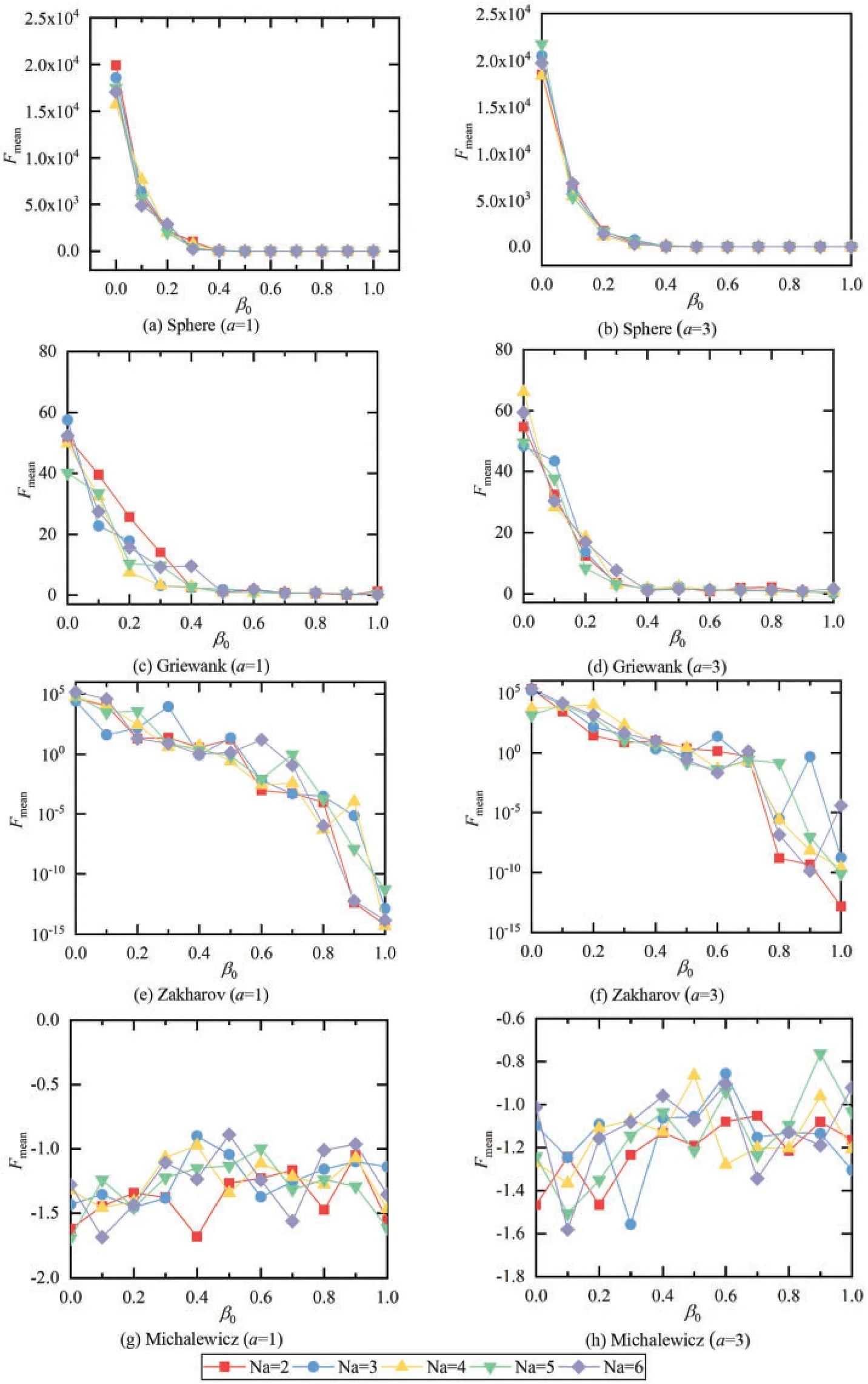
Figure 6:The changes of Fmean with β0
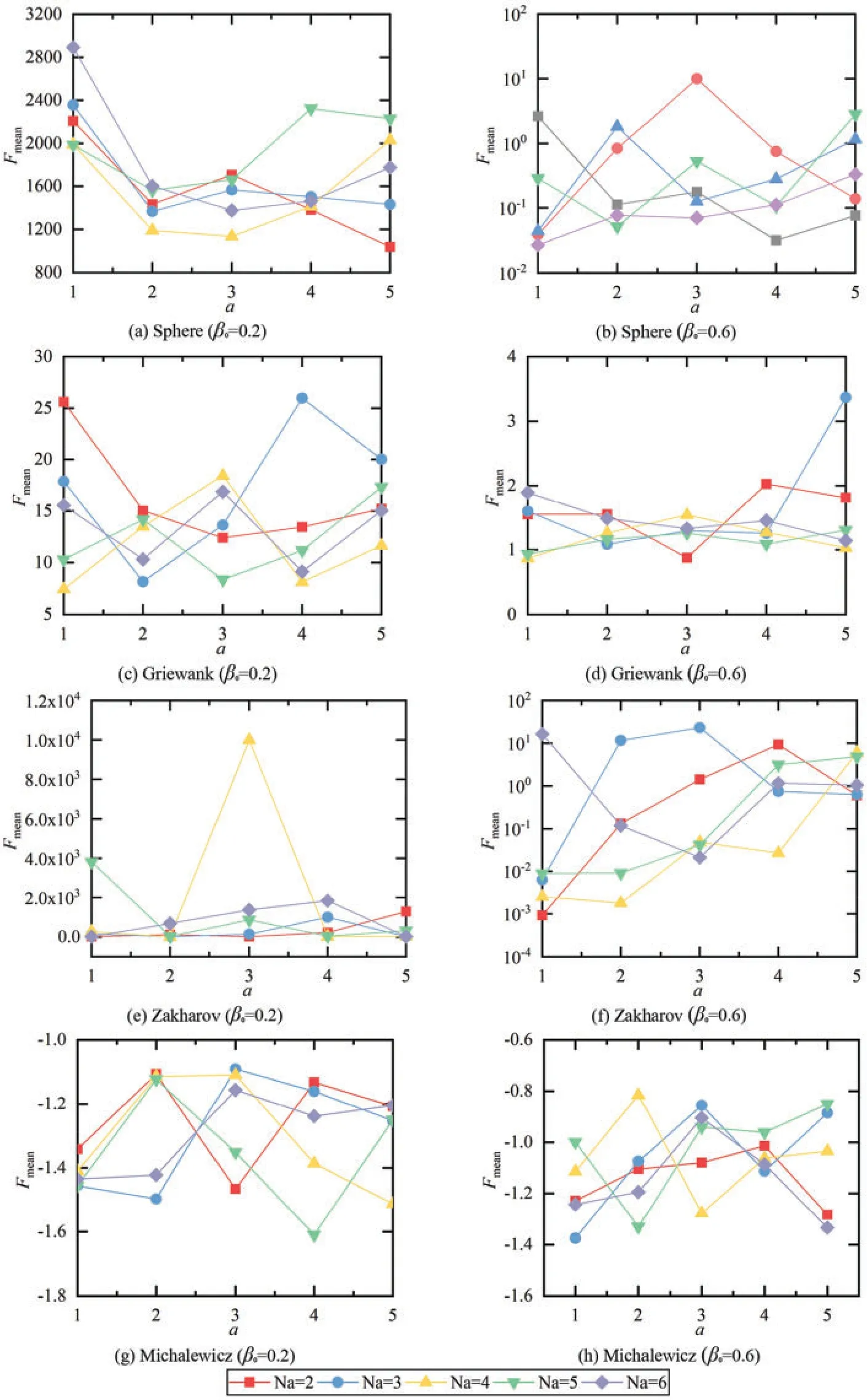
Figure 7:The changes of Fmean with a

Table 2:Mean ranks of different β0 achieved by the Friedman test

Table 3:Wilcoxon test between β0=1 and others

Table 5:Wilcoxon test between a=1 and others

Table 6:Wilcoxon test between a=4 and others

Table 7:Mean ranks of different Na achieved by the Friedman test

Table 8:Wilcoxon test between Na=4 and others

Table 9:Wilcoxon test between Na=5 and others
From Table 2,HSCFA performs best for Sphere,Griewank,and Zakharov functions whenβ0=1.Furthermore,it can be concluded from Table 3 that the algorithm performance is significantly better than others whenβ0= 1.From Table 4,a= 1 ranks first for three functions anda= 4 ranks first for one function.From Tables 5 and 6,when a=1,the results are significantly better than the other values for most of the cases.From Table 7, the rankings are different for each function andNa= 5 ranks first in Summation.From Tables 8 and 9,Na= 4 andNa= 5 are better thanNa= 6 for two functions.Based on the Friedman and Wilcoxon tests,β0=1,a=1 andNa=5 are the proper initial parameters corresponding to the optimal performance of HSCFA.
5.2 Size Optimization
5.2.1 72-Bar Space Truss Structure
The 72-bar space truss including 16 size design variables is adopted as the first example.The geometry and support conditions are shown in Fig.8.As shown in Fig.8, four additional mass are located at nodes 1–4.Table 10 summarizes the design parameters and the frequency constraints.The results of PSO[35],harmony search(HS)[36],particle swarm ray optimization(PSRO)[37],harmony search-based mechanism to PSO with an aging leader and challengers (HALC-PSO) [38], cyclical parthenogenesis algorithm (CPA) [6], SCA and FA are used for the comparison.Table 11 displays the comparison of the results, where “Best”and “Mean”are the best and mean results, “NS”is the number of analyses, and “SD” is the standard deviation of results.Table 12 presents the first five natural frequencies of the optimal results.Fig.9 shows the convergence histories of the best result of SCA,FA and HSCFA.
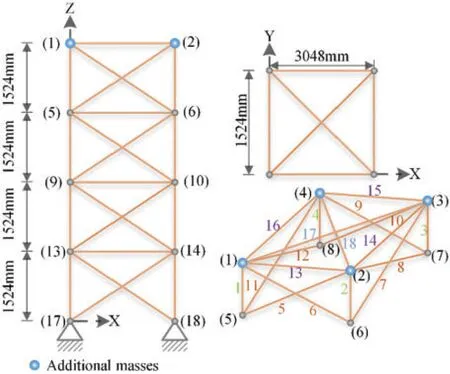
Figure 8:A 72-bar space truss structure
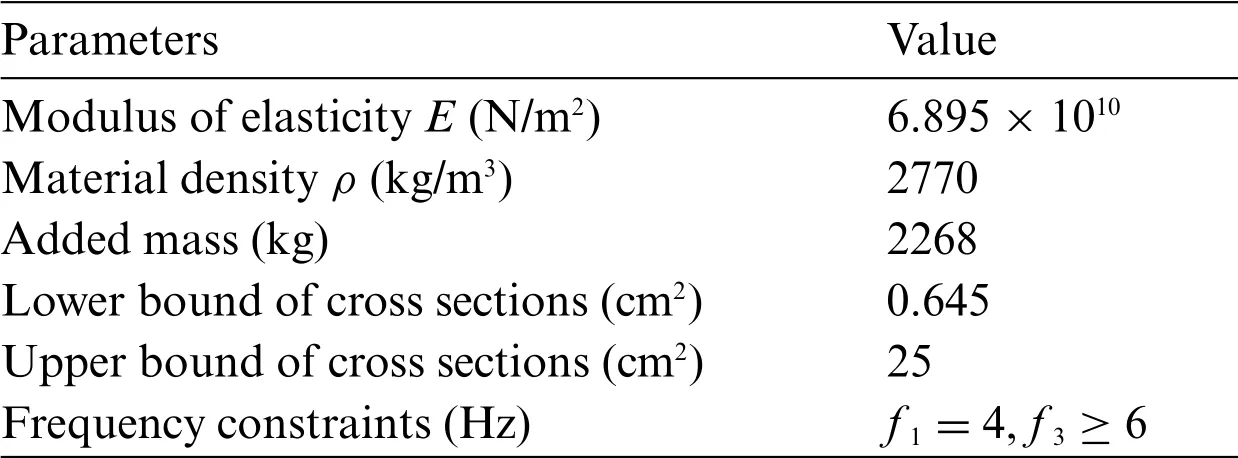
Table 10:Data for the 72-bar space truss structure

Table 11:Optimal design comparison for 72-bar space truss structure

Table 11 (continued)A(cm2) PSO[35]HS[36]PSRO[37]HALC-PSO[38]CPA[6]SCA FA MFA HSCFA-1 HSCFA-2 HSCFA A53-54 0.645 0.6450 0.645 0.6451 0.645 6.8792 4.9077 2.0244 0.6450 0.6450 0.6450 A55-58 16.684 17.4060 17.059 17.9632 16.943 15.6249 15.1759 15.0925 15.2041 16.6489 16.9026 A59-66 8.159 8.2736 7.427 8.1292 8.143 8.1066 9.5957 8.8736 8.6888 8.0145 8.1348 A67-70 0.645 0.6450 0.646 0.6450 0.647 2.8991 1.2811 0.8432 0.6450 0.6455 0.6523 A71-72 0.645 0.6450 0.645 0.6450 0.653 7.5037 6.6776 0.6556 1.2711 0.6581 0.6524 Best(kg) 328.823 328.334 329.80 327.77 328.49 390.254 370.625 351.237 338.282 328.245 328.158 Mean(kg) 332.24 332.64 334.95 327.99 330.91 424.13 405.29 360.59 341.24 331.93 330.37 SD(kg) 4.23 2.39 2.86 0.19 1.84 22.35 16.10 8.15 3.46 3.74 1.71 NS N/A 50,000 6,000 8,000 12,800 10,000 10,000 10,000 10,000 10,000 10,000

Table 12:Natural frequencies of the optimal designs for 72-bar planar truss structure
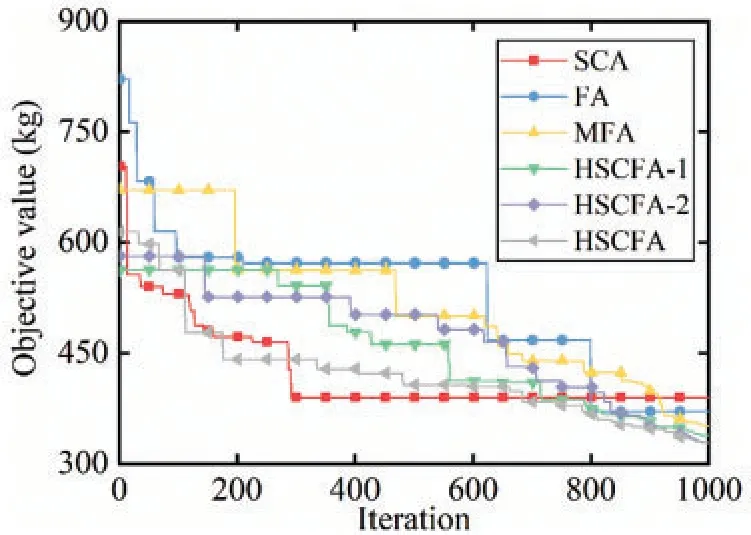
Figure 9:Iteration histories of 72-bar planar truss structure
For this experiment, the population size is 10 and the iteration is 1000 for SCA, FA, MFA,HSCFA-1,HSCFA-2,and HSCFA.Table 11 shows that HSCFA ranks second.However,the natural frequencies of HALC-PSO are 3.9985,3.9985,5.9985,6.2285 and 9.0377,which violate the frequency constraints.HSCFA achieves a significant improvement compared to SCA and FA, and HSCFA makes at least 11.46%reduction in structural weight.It also can be found that the modification of FA and the hybrid technique improve the solution accuracy of the algorithm by comparing FA,MFA and HSCFA-1.The Lévy flight and self-adaptive penalty function can enhance the robust of the algorithm through the comparison of HSCFA-1,HSCFA-2 and HSCFA.Table 12 denotes the results of HSCFA satisfy the frequency constraints.Fig.9 shows HSCFA has a faster convergence rate than SCA and FA.It is worth mentioning that the solution of HSCFA still gains improvement at the later iterations,which means the algorithm still has the ability to jump out of the local optimal.
5.2.2 120-Bar Dome Truss Structure
The 120-bar dome truss including 7 size design variables is adopted as the second example.The geometry and support conditions are shown in Fig.10.Constant concentrated masses are added to Node 1, Nodes 2–13, and the rest of all free nodes, respectively.Table 13 summarizes the design parameters and the frequency constraints.The results of PSRO[37],PSO[38],HALC-PSO[38],set theoretical multi-phase teaching-learning-based optimization(STMP-TLBO)[39],enhanced forensicbased investigation algorithm(EFBI)[40],SCA and FA are used for the comparison.Table 14 lists the comparison of the results,and Table 15 presents the first five natural frequencies of the optimal results.Fig.11 shows the convergence histories of the best result of SCA,FA and HSCFA.
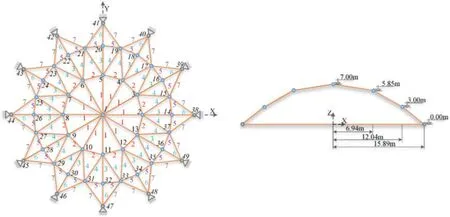
Figure 10:A 120-bar dome truss structure

Table 13:Data for the 120-bar dome truss structure
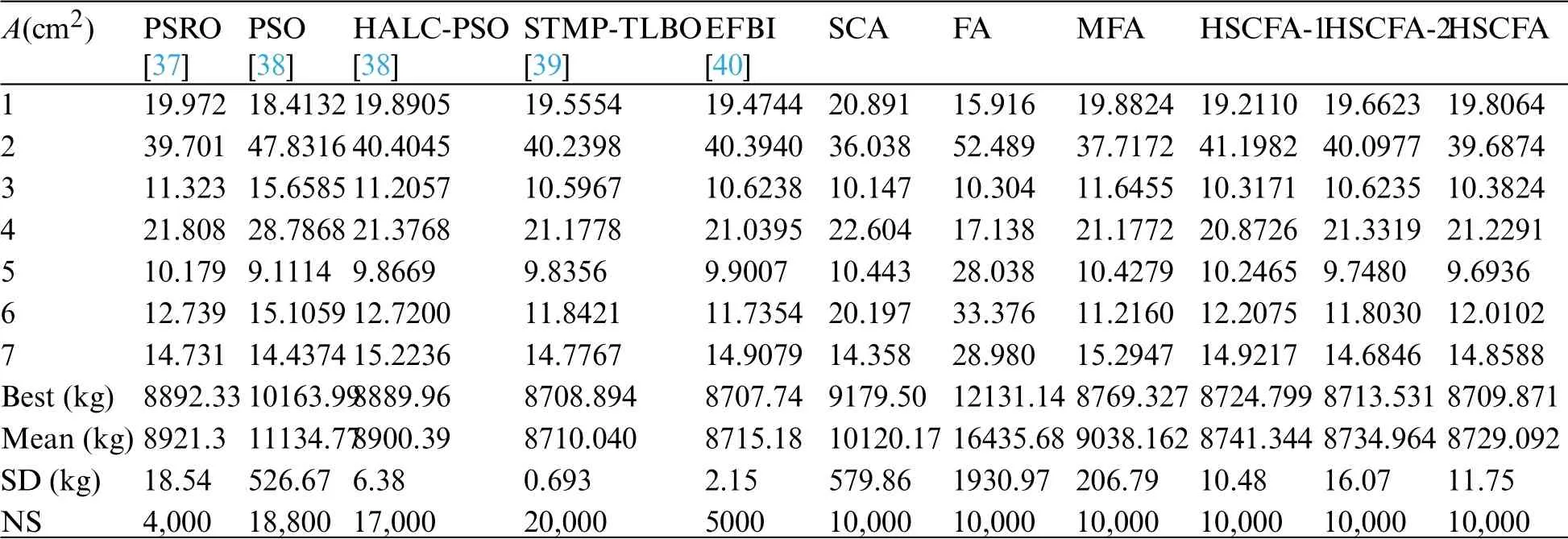
Table 14:Optimal design comparison for 120-bar dome truss structure

Table 15:Natural frequencies of the optimal designs for 120-bar dome truss structure
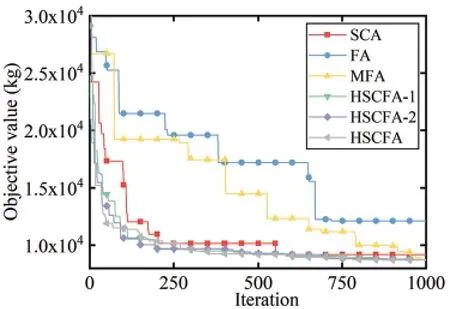
Figure 11:Iteration histories of 120-bar dome truss structure
For this experiment, the population size is 10 and the iteration is 1000 for SCA, FA, MFA,HSCFA-1, HSCFA-2, and HSCFA.Table 14 shows that HSCFA gains 5.12% and 28.20% loss of weight compared to the two original algorithms.The comparison of SCA, FA, MFA, HSCFA-1,HSCFA-2 and HSCFA denotes that the proposed strategies can improve the solution accuracy and robust.Table 15 indicates the adaptive penalty function can handle the frequency constraints well.Fig.11 shows that SCA, HSCFA-1, HSCFA-2 and HSCFA have fast convergence rate at the early iterations.However,SCA has the problem of update stagnation at the later iterations.The solutions of HSCFA-1,HSCFA-2 and HSCFA update iteratively until the termination.
5.3 Shape and Size Optimization
5.3.1 37-Bar Planar Truss Structure
The 37-bar planar truss including 5 shape and 14 size design variables is used as the third example.The geometry and support conditions are shown in Fig.12.Table 16 lists the design parameters and the allowable multiple natural frequency constraints.All the members in the lower chord have a constant cross-sectional area 40 cm2,and all the nodes in the lower chord attach a constant concentrated mass 10 kg.All nodes of the upper chord can vary from 1 m to 2.5 m in the y-axis.The results of NHPGA[41],HS[36],DPSO[5],PSRO[37],HALC-PSO[38],CPA[6],STMP-TLBO[39],SCA and FA are used for the comparison.Table 17 lists the comparison of optimal results, where “N/A”means the value is not available in the relative literature.Table 18 shows the first five natural frequencies of the optimal results.Fig.13 illustrates the convergence histories of the best result of SCA,FA and HSCFA.

Figure 12:A 37-bar planar truss structure

Table 16:Design parameters of the 37-bar planar truss structure
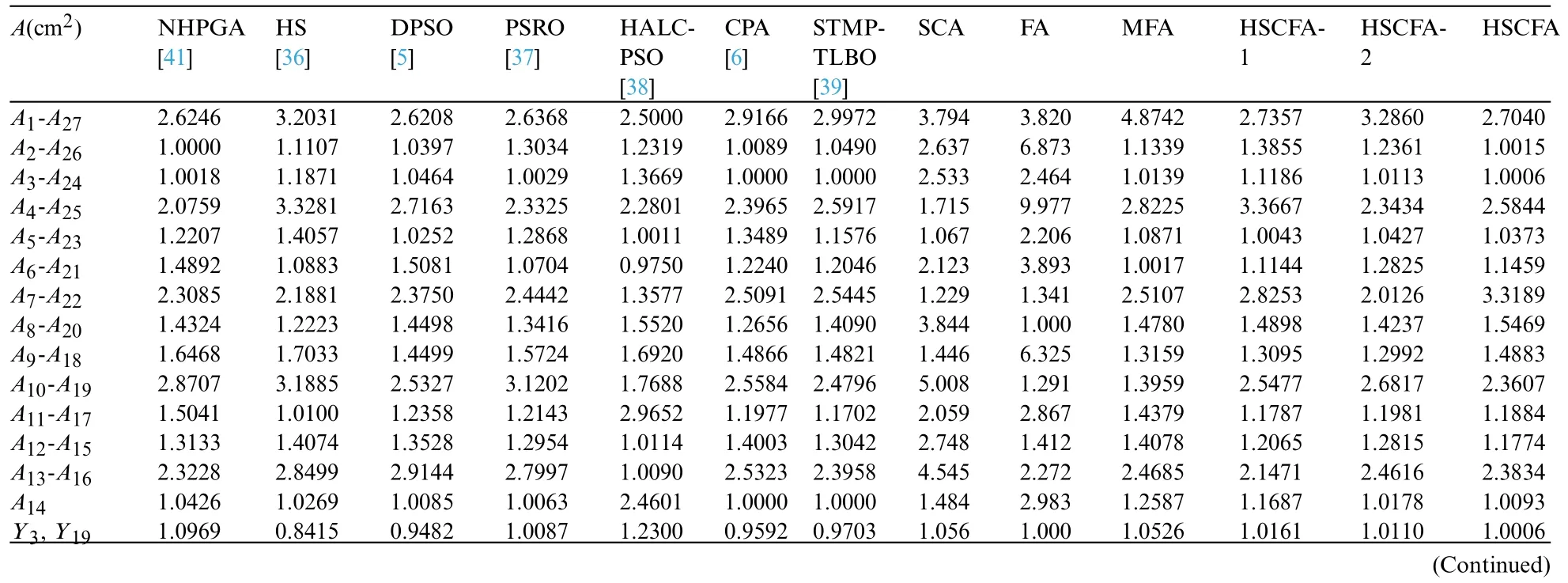
Table 17:Optimal design comparison for 37-bar planar truss structure

Table 17 (continued)A(cm2) NHPGA[41]HS[36]DPSO[5]PSRO[37]HALCPSO[38]CPA[6]STMPTLBO[39]SCA FA MFA HSCFA-1 HSCFA-2 HSCF Y5,Y17 1.4556 1.2409 1.3439 1.3985 1.2064 1.3480 1.3614 1.555 1.665 1.4063 1.3578 1.4082 1.3707 Y7,Y15 1.5954 1.4464 1.5043 1.5344 2.4245 1.5236 1.5318 1.627 1.982 1.6133 1.5158 1.5421 1.5137 Y9,Y13 1.7655 1.5334 1.6350 1.6684 1.4618 1.6617 1.6602 1.881 1.965 1.8633 1.6175 1.6581 1.6200 Y11 1.8741 1.5971 1.7182 1.7137 1.4328 1.7431 1.7404 2.024 2.129 1.8244 1.6948 1.7188 1.6997 Best(kg) 363.032 368.84 360.4 360.97 359.93 359.93 359.854 391.12 424.20 365.280 360.520 359.870 359.65 Mean(kg)381.2 N/A 362.21 362.65 360.23 360.93 360.261 405.77 449.73 371.975 361.759 361.976 359.98 SD(kg) 4.26 N/A 1.68 1.30 0.24 0.65 0.097 8.82 11.24 4.731 1.330 1.830 0.287 NS 125,000 N/A 6,000 4,000 10,000 12,800 20,000 6,000 6,000 6,000 6,000 6,000 6,000 A 05

Table 18:Natural frequencies of the optimal designs for 37-bar planar truss structure
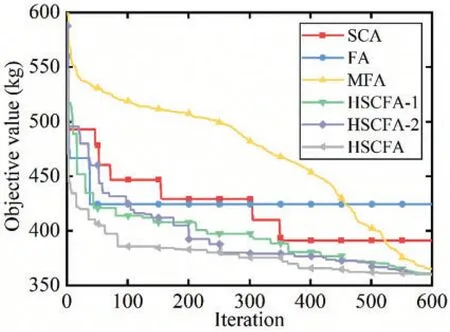
Figure 13:Iteration histories of 37-bar planar truss structure
For this experiment, the population size is 10 and the iteration is 600 for SCA, FA, MFA,HSCFA-1, HSCFA-2, and HSCFA.It can be concluded from Table 17 that HSCFA and STMPTLBO rank first and second,but HSCFA obtains the lightest design with less analyses compared to CPA.Compare to SCA,FA,MFA,HSCFA-1 and HSCFA-2,the values of“Best”,“Mean”and“SD”indicate that HSCFA makes a great improvement in the solution accuracy and robustness.Table 18 shows the results of HSCFA satisfying the frequency constraints.Fig.13 illustrates that HSCFA has the fastest convergence rate among the algorithms.
5.3.2 52-Bar Dome Truss Structure
The 52-bar dome truss including 8 size and 5 shape design variables is adopted as the fourth example.The geometry and support conditions are shown in Fig.14.Table 19 summarizes the design parameters and the allowable frequency constraints.All free nodes are permitted to move ±2 m in each allowable direction from their initial position on the basis of ensuring the symmetry of the whole structure.And constant concentrated mass is added to each free node.The results of NHPGA [41],HS[36],DPSO[5],PSRO[37],HALC-PSO[38],CPA[6],STMP-TLBO[39],EFBI[40],SCA and FA are used for the comparison.Comparison of the results and the first five frequency of best results for all the algorithms are reported in Tables 20 and 21.Fig.15 shows the convergence histories of the best result of SCA,FA and HSCFA.
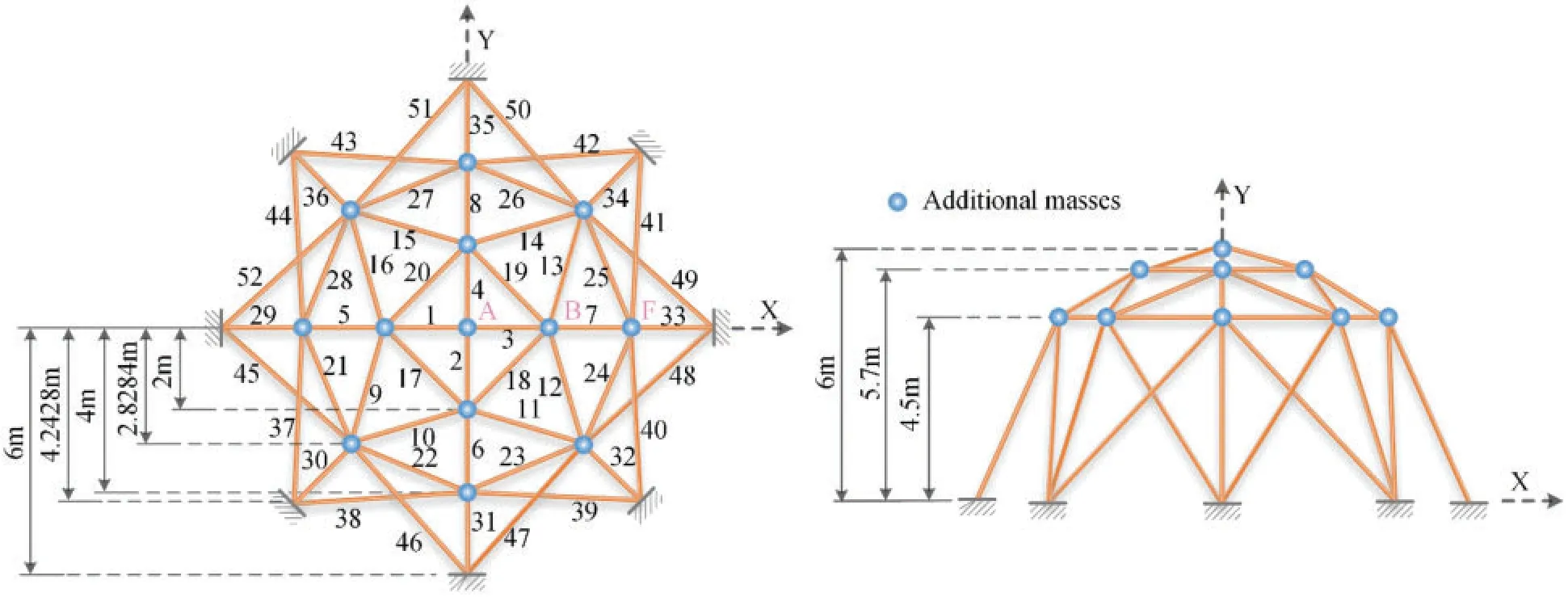
Figure 14:A 52-bar dome truss structure

Table 19:Data for the 52-bar dome truss structure

Table 20:Optimal design comparison for 52-bar dome truss structure

Table 20 (continued)A(cm2),Z, X(m)NHPGA[41]HS[36]DPSO[5]PSRO[37]HALCPSO[38]CPA[6]STMPTLBO[39]EFBI[40]SCA FA MFA HSCFA-1 HSCFA-2 HSCF XF 3.441 3.4882 4.0316 4.179 3.9630 3.9768 3.7424 3.8088 4.049 2.347 4.3068 4.0706 4.0815 3.998 ZF 3.187 2.6274 2.5036 2.501 2.5000 2.5001 2.5000 2.5000 2.519 2.810 2.5000 2.5000 2.5007 2.500 Best(kg)236.046 214.940 195.351 197.186 194.85 194.826 193.432 193.60 198.23 222.25 211.111 194.6235 194.5406 193.20 Mean(kg) 274.164 229.88 198.71 213.42 196.85 198.81 197.23 194.17 216.75 283.32 246.74 200.68 199.00 198.53 SD(kg)37.462 12.44 13.85 10.11 2.38 3.71 3.698 0.48 16.77 32.76 31.93 7.89 4.53 3.01 NS 13,519 20,000 6,000 4,000 7,500 12,800 20,000 10,000 10,000 10,000 10,000 10,000 10,000 10,000 A

Table 21:Natural frequencies of the optimal designs for 52-bar dome truss structure
For this experiment, the population size is 10 and the iteration is 1000 for SCA, FA, MFA,HSCFA-1,HSCFA-2,and HSCFA.Table 20 shows that the best solution is acquired by HSCFA.The comparison of SCA, FA, MFA, HSCFA-1, HSCFA-2 and HSCFA indicates that the improvements can successfully enhance the performance of the algorithm.Table 21 shows the design of HSCFA satisfies the frequency constraints.It can be seen from Fig.15 that HSCFA has a faster convergence rate than SCA and FA through the entire search process.
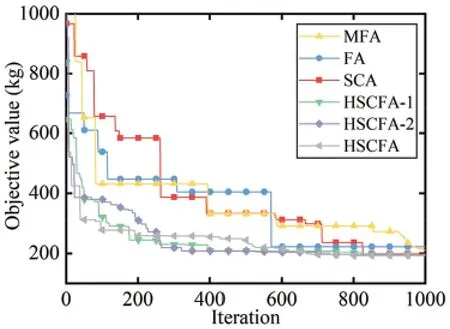
Figure 15:Iteration histories of 52-bar dome truss structure
6 Conclusions
A new hybrid metaheuristic method HSCFA is proposed to address the shape and size optimization of truss structures with nonstructural masses under multiple frequency constraints.The modified FA, SCA, Lévy flight, elitist selection technique and adaptive penalty function are integrated to construct the new method.The modified FA improves the attraction model of the standard FA by reducing the attraction number of each firefly,thus the solution accuracy is improved.The modified FA also uses the parameter of SCA instead of the original randomization parameter,which strengthens the exploitation ability of the algorithm.Lévy flight is utilized to improve the population diversity of the algorithm during the search process.Elitist selection technique is introduced into HSCFA for population selection to accelerate the convergence rate.An adaptive penalty function method considering the iteration stage,the degree and the number of constraint violations is adopted to deal with the frequency constraints.HSCFA takes advantage of the modified FA,SCA and Lévy flight to update different solutions.The modification enhances the exploration and exploitation abilities of FA and SCA with the reduction of computational complexity.
Four shape and size truss optimization problems with multiple frequency constraints are used to test the performance of HSCFA.The results demonstrate HSCFA performs better than other algorithms in the literature and achieves significant improvement compared to SCA and FA.HSCFA can obtain the lightest designs and cost the least computational time.Consequently,HSCFA provides an efficient and competitive tool for shape and size optimization problems with frequency constraints.
Funding Statement:This work is supported by the National Natural Science Foundation of China(No.11672098).
Conflicts of Interest:The authors declare that they have no conflicts of interest to report regarding the present study.
 Computer Modeling In Engineering&Sciences2023年1期
Computer Modeling In Engineering&Sciences2023年1期
- Computer Modeling In Engineering&Sciences的其它文章
- A Fixed-Point Iterative Method for Discrete Tomography Reconstruction Based on Intelligent Optimization
- A Novel SE-CNN Attention Architecture for sEMG-Based Hand Gesture Recognition
- Analytical Models of Concrete Fatigue:A State-of-the-Art Review
- A Review of the Current Task Offloading Algorithms,Strategies and Approach in Edge Computing Systems
- Machine Learning Techniques for Intrusion Detection Systems in SDN-Recent Advances,Challenges and Future Directions
- Cooperative Angles-Only Relative Navigation Algorithm for Multi-Spacecraft Formation in Close-Range
